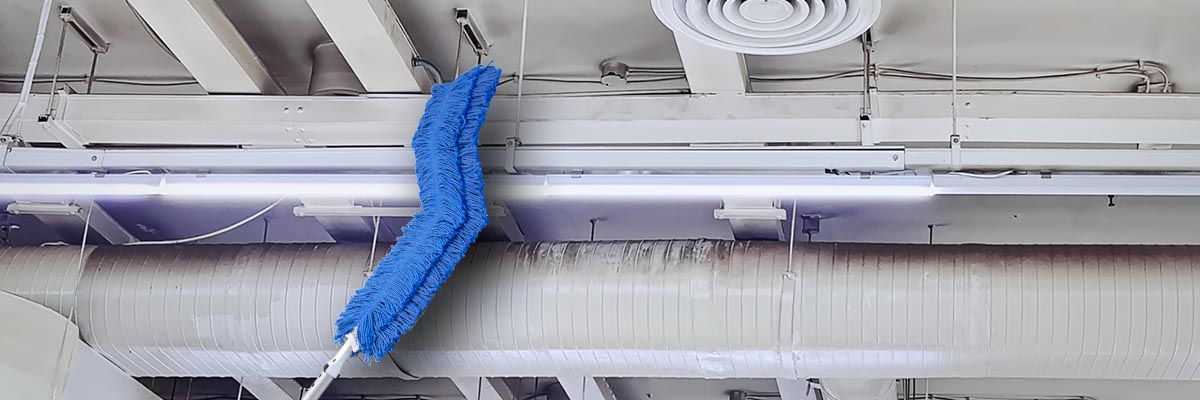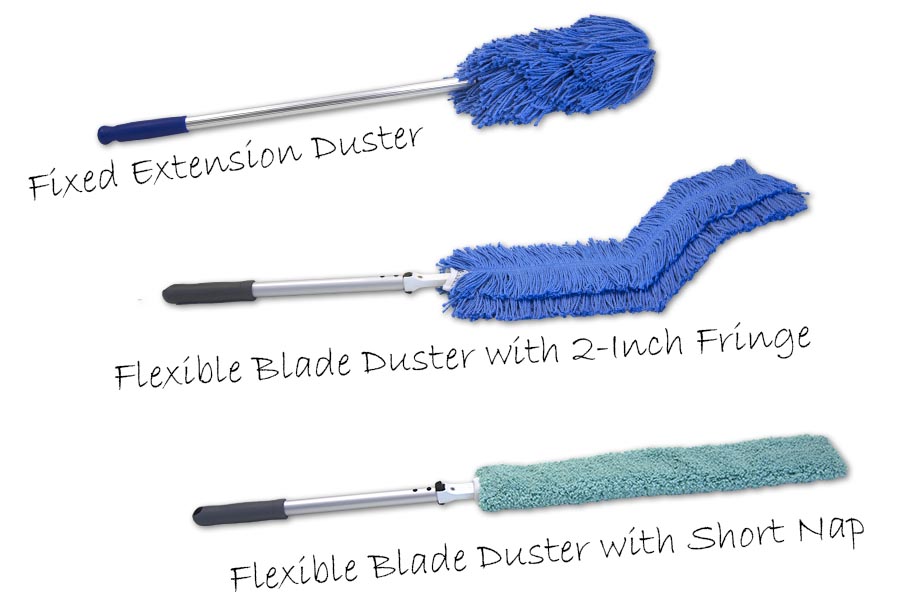Reaching New Heights: Your Guide to Dusting High Surfaces with Microfiber
In pursuing a clean and healthy facility, few chores are as essential as dusting. Beyond the aesthetic appeal of pristine surfaces, regular dusting is crucial in creating an environment that fosters well-being. Dust, often underestimated, carries more than just a visual nuisance—it harbors allergens, irritants, and potential health hazards. In this article, we will explore the importance of dusting and the best methods for getting to those hard-to-reach areas in your buildings to elevate your facilities and boost occupant well-being.

The Benefits of Dusting
Of course, the first benefit that comes to mind is improved appearance. A good dusting program helps your facility appear well-maintained. More importantly, though, dusting offers a trifecta of benefits that extend beyond visual appearance.
Improved lighting performance: Keeping light fixtures clean can positively impact their efficiency. Dust accumulation on light fixtures can reduce the amount of light they emit. By periodically dusting fixtures, you can improve the efficiency of your lighting.
Improved HVAC performance: Dust often contains particles that adversely affect indoor air quality. When the HVAC system circulates air through dusty components, it can spread these particles throughout the indoor environment. Regular dusting contributes to reductions in HVAC filtration load and better indoor air quality, and healthier spaces.
Improved occupant health. Regular dusting contributes to a healthier indoor environment by reducing allergens, improving respiratory health, and fostering overall well-being.
- Dusting helps minimize the presence of common indoor allergens such as dust mites, pet dander, and mold spores. According to the American Academy of Allergy, Asthma & Immunology (AAAAI), reducing exposure to these allergens can alleviate symptoms for individuals with allergies or asthma.
- The American Lung Association recommends dusting to remove dust mites to reduce the risk of triggering an asthma attack.
High Dusting Best Practice
By following some basic rules, you can effectively high-dust a room while minimizing your labor.
- Work from top to bottom. High dusting from top to bottom is a practical and efficient cleaning strategy that helps ensure thorough dust removal while minimizing the potential for recontamination. If you start from the bottom, dislodged dust from higher surfaces will settle on lower ones, requiring you to clean the lower surfaces again.
- Clean in a clockwise pattern. Although not a universal rule for every situation, working in a clockwise direction can help in a few ways. First, it adds consistency to your work. A systematic approach, like moving clockwise, reduces the likelihood of overlooking sections of the room. This ensures you clean every corner and surface thoroughly. Second, it reduces the possibility of re-soiling between areas caused by crossing the room.
Microfiber High Dusting Tools

Choosing the right microfiber dusting tool will help improve your productivity.
The Fixed Extension Duster - This tool features a 4-inch long fringe and is perfect for commercial HVAC diffusers. The large dusting head lets you reach inside the diffuser, cleaning the hard-to-reach surfaces. This duster is equipped with an extendable handle, giving the tool a range of 34 to 51 inches.
The Flexible Blade Duster with 2-inch Fringe - This tool features a 21-inch long flexible blade and a two-inch long fringe. Bend the tool to wrap around to clean overhead rails, shelves, or locker tops. The extra-long fringe holds an exceptional amount of dust. The irregular texture of the fringe makes this duster ideal for surfaces with crevices like decorative molding or lampshades.
Flexible Blade Duster with Short Nap - This tool features a 21-inch long flexible blade with a short nap. It is perfect for situations where a longer yarn might get snagged. It is ideal for flat, smooth surfaces like computer monitors, glass, and shelving.
Combine your duster with an extension handle to clean higher. Extension handles are either 48 inches or 72 inches long and are compatible with either blade duster.
Caring for Microfiber High Duster Heads
With proper care, microfiber dust heads can be laundered up to 150 times. First, vacuum the dust head with a HEPA vacuum cleaner after each use. If vacuuming doesn't restore the head to a usable condition, launder the dust head instead. Click here and follow the laundering process found in this article for best results.
Hillyard Can Help
At Hillyard, we understand the importance of maintaining clean and dust-free facilities, and that's why we have representatives strategically located throughout the United States to assist you in selecting the best microfiber high-dusting products for your specific needs. Whether you're looking to enhance the cleanliness of your office space, educational institution, or any other facility, our knowledgeable representatives are ready to guide you. To access their expertise, simply fill out the "I'm Interested" contact form on this webpage, and one of our dedicated representatives will promptly reach out to provide personalized assistance. Trust Hillyard to deliver top-notch solutions for your high dusting requirements, ensuring a cleaner and healthier environment for everyone.
Frequently Asked Questions
What does high dusting mean?
High dusting refers to the cleaning of elevated surfaces that are often hard to reach, such as ceiling corners, light fixtures, and HVAC components. It's a crucial maintenance practice to remove dust, allergens, and improve indoor air quality. Using specialized tools like microfiber dusters with extended handles ensures thorough cleaning of these elevated areas, contributing to a cleaner and healthier environment.
How do I do high dusting?
To effectively high dust, start from the top and work downward, minimizing recontamination. Adopt a clockwise cleaning pattern for consistency and thorough coverage. Choose the right microfiber tool, like a Fixed Extension Duster or Flexible Blade Duster, depending on the surface. Utilize extension handles for higher reach. Regularly clean and care for your microfiber dusting tools to maintain their effectiveness. Follow these practices to efficiently and comprehensively high dust, promoting a cleaner and healthier space.
How do I clean microfiber dust head?
To clean a microfiber dust head: 1. After each use, vacuum the dust head with a HEPA vacuum cleaner. 2. If vacuuming doesn't restore its condition, launder the dust head using a gentle cycle. 3. Avoid fabric softeners or bleach to preserve effectiveness. 4. Follow proper laundering guidelines. With care, microfiber dust heads can be laundered up to 150 times, ensuring ongoing cleaning performance.